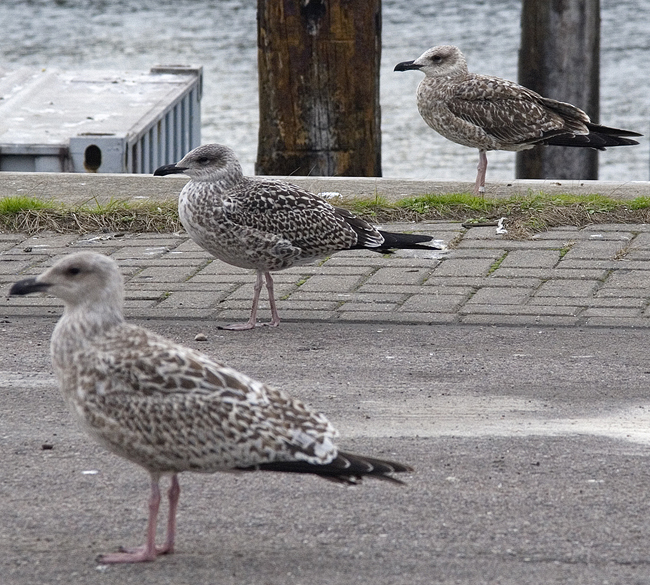 Yellow-legged
Gull - Larus michahellis
Yellow-legged
Gull - Larus michahellis
(last update: October 08 2013)
Coordinators:
Delfín González
Gabriel Martín
Antonio Gutierrez
Amir Ben Dov
Mars Muusse
Larus michahellis - 1CY October
This website deals with the Yellow-legged Gull taxon michahellis, which is a common migrant from July to December in NW Europe. After extensive expansion of the breeding population during the last three decades, it nowadays can be found breeding in Belgium, the Netherlands and Britain in mixed couples with both Herring Gull (argenteus) and Lesser Black-backed Gull (graellsii). There are subtle differences between the populations from the Mediterranean, Atlantic coast of Portugal and Morocco and from the islands in the Atlantic. Most pronounced differences can be found in the taxon atlantis, now regarded as full species by some authors and birds along the Atlantic coast of the Iberian peninsular: lusitanius. Both atlantis and lusitanius are treated in their own sections on this website.
General description:
In the Netherlands, most michahellis can be found in October. October 10 2001, over 60 were present at a single location, the Maasvlakte, near the port of Rotterdam. Many local Lesser Black-backed Gulls leave the breeding grounds and migrate south, contra the northbound migration of michahellis. In the Netherlands, the majority of 1CY LBBG's now originate from Scandinavian populations and these fresh and neat looking birds contrast strongly from michahellis, which shows strongly worn juvenile covert fringes and tertials. Some 1CY michahellis at Le Portel (NW France) are metal-ringed or colour-ringed and they apparently originate from southern France (Marseille and islands in the Mediterranean), Italy, Croatia and Switzerland.
Moult stage and pace in the scapulars:
In 1CY michahellis, there
are almost no birds left with juvenile feathers in the scapulars and mantle
feathers. These feathers are almost completely replaced by second
generation feathers (except probably three or four rear lowest lower
scapulars). The last moulted scapulars show a brownish or buffish
based centre between the dark bars or anchor pattern and the
feathers have a broad white fringe.
The table below presents the results of scapular moult in early
October 2002 at Etaples and Boulogne-sur-Mer, Pas
de Calais, NW France. The complete table can be found here (140 kB). By early October, all upper scapulars have been replaced
for second generation feathers in both samples (n = 21 and n = 30).
In the lower scapulars, it's normally the last three or four rear
scapulars in the lowest row (the ones covering the scapular coverts)
which may still be juvenile. In most birds, these rear lower
scapulars may be shed as well by the end of the month. As a result,
the average 1CY michahellis have a complete second generation
scapular region at the start of winter. It has to be said that birds
with score C (50-74% moulted lower scapulars) by early October were
on the far end of this class, so close to 75%.
Moult stage and pace in the wing-coverts:
The amount of replaced coverts and tertial vary to a large extend, just as it did in September. 2CY michahellis in spring may still show all the wing-coverts juvenile, so must have suspended moult in October in 1CY as well. But most 1CY birds have replaced at least a few (inner coverts) to second generation feathers. This moult started already in September and continues in October. A few birds may still start wing-covert moult and tertial moult in the last days of September and by the end of October, only 15-20% of the birds show complete juvenile wing-coverts and tertials. As a result: Over 80% has started partial moult (post-juvenile moult) in their first calendar year.
The average moult stage by the first week of October is: almost all scapulars and mantle replaced completely for second generation feathers; 3 to 4 inner greater coverts replaced (with often a single inner greater retained juvenile); about 8 inner median coverts moulted (again sometimes one inner covert left unmoulted in some birds); the moult in the lesser and lower lesser coverts quite random, but concentrated in the inner half of the tracts and in some birds one tertial moulted (often the third). Some birds still show a complete juvenile wing, with abraded coverts (especially the inner coverts) and juvenile tertials. These 1CY michahellis birds strongly resemble graellsii when the wings are folded and the bird rests. For a nice example, see the Swiss-ringed michahellis in image 6773. This kind of 1CY birds (Sempach birds) are very hard to tell from graellsii, even more since they breed in the northernmost colonies of the michahellis range. They therefore may hatch slightly later in the season and in turn the abrasion in the coverts may appear to be more in line with graellsii which may breed at the same latitude.
The most advanced birds started
wing-covert moult two months ago (August) and show many second
generation coverts by mid-October; in some birds about 50% of the
visible wing-coverts. Two examples can be found on this
page, showing two colour-ringed birds from soutern Italy
with very advanced wing-covert and tertial moult.
Normally, the wing-covert moult is most advanced in the median covert
row, notwithstanding the slightly higher score in the lesser coverts
in the sample of October 03 2002 (n = 21).
Advanced birds include the upper tertials in the autumn moult, but
some birds may moult a central or a few central tertials (often
starting with the third tertial). The juvenile tertials are plain
brown centred and the fringes are completely gone, leaving a
protruding shaft streak, where the new second generation tertials
often show a barred pattern with neat fringes.
From the table below, the following results can be extracted:
- by early October, about 75-80% of 1CY michahellis start moult in the tertials or wing-coverts (19-27% still shows a complete juvenile wing).
- a minority of about 40% start tertial moult by early October.
- about 10-14% of the wing-coverts and tertials is included in the partial moult by early October (missing, growing and fully grown feathers included).
Moult stage and pace in the rectrices:
Scanning flocks of 1CY michahellis, one may regularly encounter birds with moulted rectrices. Examples of such birds can be found here and here. Moult in the tail-feathers may start from early October (maybe already from late September?) to late October. By late October, about 5% of 1CY michahellis started moult in the rectrices. Of these birds, most are still missing tail-feathers (so actively growing feathers) and moult may continue in November. The complete extend of this moult is yet unknown, but by May, 2CY michahellis may show a completely moulted tail with all tail-feathers second generation. An example of such a bird can be found here.
Tables
The moult stage of 1CY michahellis from October can be found in this spreadsheet.
Juvenile michahellis moult score October 2002 at Pas-de-Calais, NW France: for the complete table of results click here (140 kB). The table below shows a summary. |
||||||
| 03 Oct 2002 (n: 21) | 04 Oct 2002 (n: 30) | |||||
| min (0) | max (50) | aver | min (0) | max (50) | aver | |
| tt | 0 (62%) | 21 | 3.6 | 0 (60%) | 25 | 5.3 |
| gc | 0 (57%) | 6 | 2.0 | 0 (47%) | 16 | 2.5 |
| mc | 0 (38%) | 22 | 6.8 | 0 (33%) | 50 | 13.1 |
| llc | 0 (38%) | 19 | 5.8 | 0 (40%) | 45 | 7.7 |
| lc | 0 (29%) | 22 | 7.2 | 0 (43%) | 40 | 6.8 |
| tot: | 19% | - | 10% | 27% | - | 14% |
| second generation scapulars: A (100%), B (75-99%), C (50-74%) | ||||||
| A | B | C | A | B | C | |
| us | 21 (100%) | - | - | 30 (100%) | - | - |
| ls | 1 (5%) | 18 (86%) | 2 (10%) | - | 28 (93%) | 2 (7%) |
| tot | 1 (5%) | 18 (86%) | 2 (10%) | - | 28 (93%) | 2 (7%) |
| Notes: In this table the moult of wing-coverts and tertials is presented. For all feather tracts, a maximum score of 50 is possible, when all juvenile feathers in a tract are replaced by second generation feathers which in turn are all fully grown. Growing or missing feathers are valued half score. Hence, if all feathers in one tract are missing or growing, the maximum score is 25. If all feathers in a tract are still juvenile, the score is 0. In the total score, all class scores are added, so the maximum score is 250 (100% second generation tertials and wing-coverts). |
||||||
 Yellow-legged Gull michahellis U3DH 1CY, October 09 2014, Ashdod, Israel. Picture: Amir Ben Dov.
Yellow-legged Gull michahellis U3DH 1CY, October 09 2014, Ashdod, Israel. Picture: Amir Ben Dov.  Yellow-legged Gull michahellis U6AH 1CY, May, June & October 2011, Israel. Pictures: Amir Ben Dov.
Yellow-legged Gull michahellis U6AH 1CY, May, June & October 2011, Israel. Pictures: Amir Ben Dov.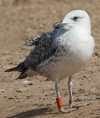 Yellow-legged
Gull michahellis 1CY U8CA October 29 2010, Ramat Gan Safari, Israel. Picture: Amir Ben Dov.
Yellow-legged
Gull michahellis 1CY U8CA October 29 2010, Ramat Gan Safari, Israel. Picture: Amir Ben Dov.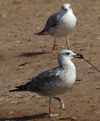 Yellow-legged
Gull michahellis 1CY U9BH October 29 2010, Ramat Gan Safari, Israel. Picture: Amir Ben Dov.
Yellow-legged
Gull michahellis 1CY U9BH October 29 2010, Ramat Gan Safari, Israel. Picture: Amir Ben Dov. Yellow-legged
Gull michahellis 1CY NTT8
October 11-17 2002, IJmuiden, the Netherlands. Ringed on Mendes Island, NE Spain.
Yellow-legged
Gull michahellis 1CY NTT8
October 11-17 2002, IJmuiden, the Netherlands. Ringed on Mendes Island, NE Spain. Yellow-legged
Gull michahellis 1CY ILZB & IKZH October 26 2002, Etaples &
Boulogne-sur-Mer, France.
Yellow-legged
Gull michahellis 1CY ILZB & IKZH October 26 2002, Etaples &
Boulogne-sur-Mer, France. Yellow-legged
Gull michahellis 1CY 453T October 13 2001, Westkapelle, the Netherlands. From Camarque colony, S France.
Yellow-legged
Gull michahellis 1CY 453T October 13 2001, Westkapelle, the Netherlands. From Camarque colony, S France. Yellow-legged
Gull michahellis 1CY 793X October 03-04 2002, Etaples, France. Ringed in southern France.
Yellow-legged
Gull michahellis 1CY 793X October 03-04 2002, Etaples, France. Ringed in southern France. Yellow-legged
Gull michahellis 1CY HES
885629 October 01 2001, Le Portel,
France. Ringed in Switzerland, resembling graellsii.
Seen again in June 2002.
Yellow-legged
Gull michahellis 1CY HES
885629 October 01 2001, Le Portel,
France. Ringed in Switzerland, resembling graellsii.
Seen again in June 2002. Yellow-legged
Gull michahellis 1CY HES
894231 October 03 2002, Le Portel,
France. Ringed in Switzerland.
Yellow-legged
Gull michahellis 1CY HES
894231 October 03 2002, Le Portel,
France. Ringed in Switzerland. Yellow-legged
Gull michahellis 1CY HES
894333 October 04 2002, Etaples,
France. Ringed in Switzerland.
Yellow-legged
Gull michahellis 1CY HES
894333 October 04 2002, Etaples,
France. Ringed in Switzerland. Yellow-legged
Gull michahellis 1CY-2CY HES M002320 October 2005 - September 2006, Portalban, Switzerland. Picture: Stephane Aubry.
Yellow-legged
Gull michahellis 1CY-2CY HES M002320 October 2005 - September 2006, Portalban, Switzerland. Picture: Stephane Aubry. Yellow-legged
Gull michahellis 1CY HES M002563 October 06 2005, Chevroux, Switzerland. Picture: Stephane Aubry.
Yellow-legged
Gull michahellis 1CY HES M002563 October 06 2005, Chevroux, Switzerland. Picture: Stephane Aubry.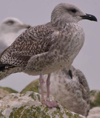 Yellow-legged
Gull michahellis 1CY HES M015793 October 06 2005, Chevroux, Switzerland. Picture: Stephane Aubry.
Yellow-legged
Gull michahellis 1CY HES M015793 October 06 2005, Chevroux, Switzerland. Picture: Stephane Aubry. Yellow-legged
Gull michahellis HES M016797 1CY, October 28 2010, Gouda, the Netherlands. Picture: Johannes Luiten.
Yellow-legged
Gull michahellis HES M016797 1CY, October 28 2010, Gouda, the Netherlands. Picture: Johannes Luiten. Yellow-legged
Gull michahellis 1CY HES M0xxxxx October 05 2005, Chablais de Cudrefin, Switzerland. Picture: Stephane Aubry.
Yellow-legged
Gull michahellis 1CY HES M0xxxxx October 05 2005, Chablais de Cudrefin, Switzerland. Picture: Stephane Aubry. Yellow-legged Gull michahellis 20W 1CY, October 18 2013, Westkapelle, the Netherlands. Picture: Maarten van Kleinwee.
Yellow-legged Gull michahellis 20W 1CY, October 18 2013, Westkapelle, the Netherlands. Picture: Maarten van Kleinwee.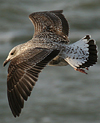 Yellow-legged
Gull michahellis 1CY & 4CY 70Y October 2008 & November 2011, The Netherlands & Belgium.
Yellow-legged
Gull michahellis 1CY & 4CY 70Y October 2008 & November 2011, The Netherlands & Belgium. Yellow-legged Gull michahellis 1CY & 3CY S3T5 October 2008 & August 2010, Poland. Picture: Adam Janczyszyn & Blazej Nowak.
Yellow-legged Gull michahellis 1CY & 3CY S3T5 October 2008 & August 2010, Poland. Picture: Adam Janczyszyn & Blazej Nowak. Yellow-legged Gull michahellis 1CY S8ZP October 01 2007, Croben, Sachsen, Germany (51.14 N 12.25 E). Picture: Jürgen Steudtner.
Yellow-legged Gull michahellis 1CY S8ZP October 01 2007, Croben, Sachsen, Germany (51.14 N 12.25 E). Picture: Jürgen Steudtner. Yellow-legged Gull michahellis 1CY SE5U October 27 2013, Jakuševec landfill, Zagreb, Croatia. Picture: ringing team Luka Jurinovic.
Yellow-legged Gull michahellis 1CY SE5U October 27 2013, Jakuševec landfill, Zagreb, Croatia. Picture: ringing team Luka Jurinovic. Yellow-legged Gull michahellis 1CY 3F4 October 27 2013, Pantín, Spain. Picture: Antonio Gutierrez.
Yellow-legged Gull michahellis 1CY 3F4 October 27 2013, Pantín, Spain. Picture: Antonio Gutierrez.
Tail-feather moult in 1CY:
.
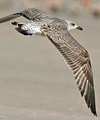 Yellow-legged Gull michahellis 1CY, October 04 2007, Alexandroupoli, Greece. Photo: Visa Rauste.
Yellow-legged Gull michahellis 1CY, October 04 2007, Alexandroupoli, Greece. Photo: Visa Rauste. Yellow-legged
Gull michahellis 1CY, October 18 2002, Westkapelle,
the Netherlands.
Yellow-legged
Gull michahellis 1CY, October 18 2002, Westkapelle,
the Netherlands.
 Yellow-legged
Gull michahellis 1CY, October 03 2002, Le Portel,
France.
Yellow-legged
Gull michahellis 1CY, October 03 2002, Le Portel,
France. Yellow-legged Gull michahellis 1CY, October 02 2007, Kavala, Greece. Photo: Visa Rauste.
Yellow-legged Gull michahellis 1CY, October 02 2007, Kavala, Greece. Photo: Visa Rauste.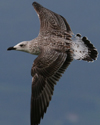 Yellow-legged
Gull michahellis 1CY, October 02 2006, Chevroux, Switzerland. Picture: Stephane Aubry.
Yellow-legged
Gull michahellis 1CY, October 02 2006, Chevroux, Switzerland. Picture: Stephane Aubry. Yellow-legged
Gull lusitanius 1CY, October 18 2011, Gijon, Spain. Photo: Iván Díaz Pallarés.
Yellow-legged
Gull lusitanius 1CY, October 18 2011, Gijon, Spain. Photo: Iván Díaz Pallarés. Yellow-legged
Gull michahellis 1CY, October 01 2012, Westkapelle, the Netherlands.
Yellow-legged
Gull michahellis 1CY, October 01 2012, Westkapelle, the Netherlands. Yellow-legged
Gull michahellis 1CY, October 01 2012, Westkapelle, the Netherlands.
Yellow-legged
Gull michahellis 1CY, October 01 2012, Westkapelle, the Netherlands. Yellow-legged
Gull michahellis 1CY, October 01 2001, Le Portel,
France.
Yellow-legged
Gull michahellis 1CY, October 01 2001, Le Portel,
France.
 Yellow-legged
Gull michahellis 1CY, October 01 2001, Le Portel,
France. All coverts still juvenile.
Yellow-legged
Gull michahellis 1CY, October 01 2001, Le Portel,
France. All coverts still juvenile. Yellow-legged
Gull michahellis 1CY, October 01 2001, Le Portel,
France.
Yellow-legged
Gull michahellis 1CY, October 01 2001, Le Portel,
France. Yellow-legged
Gull michahellis 1CY, October 01 2001, Le Portel,
France.
Yellow-legged
Gull michahellis 1CY, October 01 2001, Le Portel,
France. Yellow-legged
Gull michahellis 1CY, October 01 2001, Le Portel,
France.
Yellow-legged
Gull michahellis 1CY, October 01 2001, Le Portel,
France. Yellow-legged
Gull michahellis 1CY, October 01 2001, Le Portel,
France. Another Swiss individual?
Yellow-legged
Gull michahellis 1CY, October 01 2001, Le Portel,
France. Another Swiss individual?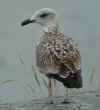 Yellow-legged
Gull michahellis 1CY, October 03 2002, Etaples, France. Only few coverts moulted.
Yellow-legged
Gull michahellis 1CY, October 03 2002, Etaples, France. Only few coverts moulted. Yellow-legged
Gull michahellis 1CY, October 03 2002, Le Portel,
France.
Yellow-legged
Gull michahellis 1CY, October 03 2002, Le Portel,
France. Yellow-legged
Gull michahellis 1CY, October 14 2001, Westkapelle,
the Netherlands. Some of these first winter scapulars already look
abraded.
Yellow-legged
Gull michahellis 1CY, October 14 2001, Westkapelle,
the Netherlands. Some of these first winter scapulars already look
abraded. Yellow-legged
Gull michahellis 1CY, October 13 2001, Westkapelle,
the Netherlands.
Yellow-legged
Gull michahellis 1CY, October 13 2001, Westkapelle,
the Netherlands.  Yellow-legged
Gull michahellis 1CY, October 22 2001, Westkapelle,
the Netherlands.
Yellow-legged
Gull michahellis 1CY, October 22 2001, Westkapelle,
the Netherlands. Yellow-legged
Gull michahellis 1CY, October 22 2001, Westkapelle,
the Netherlands. Sunset gives a warm orange tone.
Yellow-legged
Gull michahellis 1CY, October 22 2001, Westkapelle,
the Netherlands. Sunset gives a warm orange tone.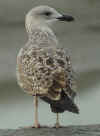 Yellow-legged
Gull michahellis 1CY, October 24 2002, Etaples, NW
France.
Yellow-legged
Gull michahellis 1CY, October 24 2002, Etaples, NW
France. Yellow-legged
Gull michahellis 1CY, October 24 2002, Etaples, NW
France.
Yellow-legged
Gull michahellis 1CY, October 24 2002, Etaples, NW
France. Yellow-legged
Gull michahellis 1CY, October 04 2002, Etaples,
France.
Yellow-legged
Gull michahellis 1CY, October 04 2002, Etaples,
France.